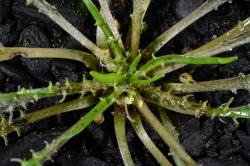- Taxon
- Gallery
- = Plantago hamiltonii Kirk, Trans. & Proc. New Zealand Inst. 11: 465 (1879)
- = Plantago masoniae Cheeseman, Trans. New Zealand Inst. 53: 424 (1921) – as masonae
- ≡ Plantago triandra subsp. masoniae (Cheeseman) Sykes, New Zealand J. Bot. 26: 322-323 (1988) – as masoniae
Rosette plants; primary root 2–12 mm thick. Leaves all basal, 7–62 to per rosette, usually brown, sometimes green when dry, usually narrowly angular–ovate, sometimes narrowly elliptic, linear, narrowly angular–obovate or narrowly ovate, rarely narrowly rhombic, widest point usually below middle or sometimes at middle, 8–61 mm long, 0.7–11 mm wide; axillary hairs rust coloured, usually slightly to very visible, rarely not visible, up to 2–13 mm long. Lamina narrowly ovate or narrowly angular–ovate, widest point below middle, 5–57 mm long, punctate or not punctate, glabrous or with bands or patches of isolated hairs or sparsely hairy especially toward middle of leaf adaxially, glabrous abaxially; hairs patent and 0.3–1.1 mm; veins 1; lamina apex acute; base usually attenuate, rarely cuneate; margins subentire with irregular wavy margins, with 0–24 minute, small or medium, rarely large, obtuse, regular teeth up to 0.2–3.6 mm long, glabrous or with isolated hairs especially near teeth tips, rarely sparsely hairy; petiole often distinguishable from lamina, 1–23 mm long, 0.4–3.6 mm wide at narrowest point. Inflorescences erect, 0–22 per rosette, 4–41 mm long (including spikes); scapes usually sessile, rarely elongating before anthesis, not ribbed, 0–38 mm long, 2–7 mm thick at fruiting, glabrous, with isolated hairs, sparsely hairy or densely hairy; trichomes antrorse, type ‘i’? (difficult to assess); spikes globose, 2–5 mm long, 2–7 mm thick at fruiting. Flowers 1–3 per spike, densely crowded; bracts 1? per flower, narrowly ovate, ovate, broadly ovate or very broadly ovate, usually acute, rarely obtuse, 0.4–3.4 mm long, 0.4–1.4 mm wide (as is or flattened); bract margins usually glabrous, sometimes with isolated hair near apex and outer surface glabrous; bract axils usually with isolated hairs or sparsely hairy, rarely densely hairy, 0.5–3.2 mm long; calyx much shorter than capsule, 0.4–1.9 mm long, 0.9–3.2 mm wide; calyx lobes usually ovate or broadly ovate, rarely very broadly ovate, usually acute, rarely obtuse, 0.3–1.7 mm long, 0.3–1.1 mm wide; calyx lobe margins scarious and usually glabrous, rarely with isolated hair at apex, middle coloured part 0.1–0.4 mm wide, outer surface glabrous; corolla tube 2.0–4.4 mm long, longer than lobes; corolla lobes narrowly ovate or ovate, acute, 0.9–2.9 mm long, 0.3–0.9 mm wide; stamen filaments 1.7–6.8 mm long, attached to lower half of corolla tube 0.2–1.8 mm from tube base; anthers 0.7–1.4 mm long (including appendix); style 2.7–10.0 mm long, densely hairy throughout; stigma filiform, undifferentiated from style or rarely with a thin hook; ovary 0.7–2.6 mm long, 0.3–1.7 mm wide; ovules 25–42. Capsules usually ellipsoid or globose, rarely ovoid or broadly ovoid, widest at usually middle, rarely lower half, septum not reaching top of capsule, not forming an upper compartment to one side, 2.1–4.3 mm long, 1.5–3.9 mm wide, 0.4–2.7 mm deep; lower portion 0.9–2.7 mm long, cup-shaped. Seeds 8–42 per capsule, uniform, usually rhomboid, broadly rhomboid, angular–ovoid or broadly angular–ovoid, rarely ellipsoid, broadly ellipsoid or pyramidal, rust, brown or dark brown, 0.5–1.4 mm long, 0.3–0.9 mm wide; edges angular.
[Reproduced from Meudt (2012, New Zealand J. Bot. 50: 101–178) with permission from The Royal Society of New Zealand.]
Flowering: Dec.–Mar.




